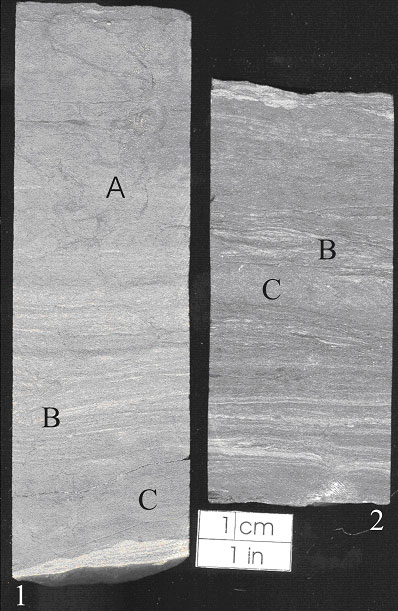 |
|
Kansas Geological Survey Open-file Report 2003-82 |
2.1.6 Laminated Muddy Sandstone Facies
Description
The laminated muddy sandstone facies is composed of dark-gray silt and mud
and light-gray fine-grained sand (Figure 2.08). Diagnostic features of the
facies are intervals (0.5-1 cm) of thin laminae (3 mm) of siltstone and sandstone
that are separated by intervals (0.5-1 cm) dominated by bioturbated to laminated
mudstone (1-3 mm). Many of the laminated intervals are cross-stratified, and
have bimodal orientations. Contacts between the top of the mudstone and the
bottom of the sandstone may be reactivation surfaces. Minor amounts of plant
fragments are scattered through the facies (Figure 2.08). Body fossils were
not observed, although bioturbation is prevalent along with sparse actively
filled vertical and horizontal burrows. Thickness of the facies ranges from
5 to 12 feet (1.5 to 3.7 m). Contacts with the overlying and underlying facies
are gradational.
Paleoenvironmental Interpretation
The laminated muddy sandstone facies is interpreted as having been deposited
in a tidal-flat environment. Alternating fine-grained sand cross laminations
and thicker mudstone laminations indicate bedload transport during variable
tidal flow and sediment fallout during slack-water (Reineck and Singh, 1980).
Presence of reactivation surfaces and cross lamination dipping in opposite
directions indicates changes in flow direction and suggests tidal influence.
Open-marine tidal flats often have an abundant and diverse trace fossil assemblage
(Buatois et al., 1999). The paucity of trace and body fossils preserved in
this setting may be due to the muddy system or freshwater influence from tidal
channels. Historically, the cross-laminated muddy sandstone facies would be
interpreted as part of the “outside shale” in the cyclothem model
(Heckel, 1977).
 |
| Figure 2.08 - Polished core section of laminated muddy sandstone facies. 1) Intercalated intervals of cross-stratified muddy sandstone (B) and laminated to bioturbated and burrowed mudstone (C). At top of core section abundant rooting has disrupted primary sedimentary structures (A). 2) Inercalated intervals of cross-stratified sandstone and mudstone (B) separated by intervals of laminated to bioturbated mudstone. Sample 1 from 881' and sample 2 from 851' in the Hinthorn CW#1 well, 14-T32S-R16E, Montgomery County, Kansas |
e-mail : webadmin@kgs.ku.edu
Last updated December 2003
http://www.kgs.ku.edu/PRS/publication/2003/ofr2003-82/chapter2_6.html